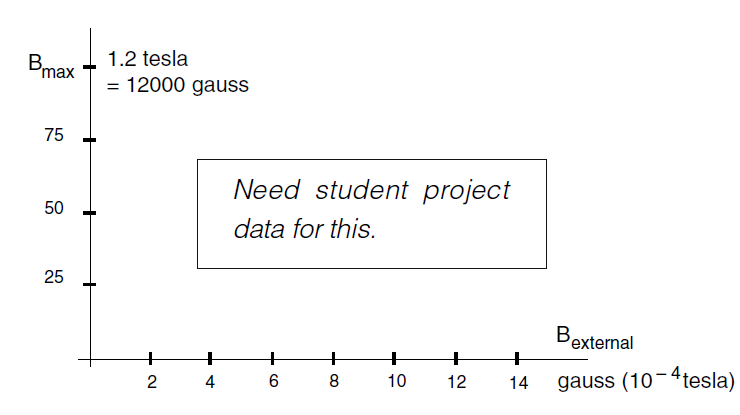The Iron Core Inductor
When the external field is less than 2 gauss in Figure (1), we have a more or less linear relationship shown by the dotted line between the external field and the field in the iron. In this region of the curve, for Bext < 2 gauss, the iron is essentially acting as a magnetic field amplifier. For this sample, a 2 gauss external field produces a 50,000 gauss magnetic field in the iron, an amplification by a factor of 25,000.
If we amplify the magnetic field in our solenoid 25,000 times, we are also amplifying the magnetic flux ΦB by the same factor. If we have a varying current in the solenoid, but keep Bext under 2 gauss, we will get a varying magnetic field in the iron and a varying magnetic flux ΦB that is roughly proportional to the current i in the solenoid. The difference that the iron makes is that the flux ΦB, and the rate of change of flux dΦB/dt will be 25,000 times larger. And so will the induced voltage in the turns of the solenoid. This means that the inductance of the solenoid is also increased by 25,000 times. If we inserted an iron ring into our air core solenoid, and the iron had the same magnetic properties as the iron sample studied in Figure (1), the inductance of our toroidal solenoid would increase 25,000 times from 1.8 × 10-4 henry up to about 4 henrys.

Figure 1: Example of a magnetization curve for magnetically soft iron. The impressive feature is that an external field of only a few gauss can produce fields in excess of xxxxx gauss inside the iron.
We can easily get large inductances from iron core inductors, but there are certain disadvantages. The curve in Figure (1) is not strictly linear, therefore the inductance has some dependence on the strength of the current in the coil. When we use an AC current in the solenoid, the iron atoms have to flip back and forth to keep their magnetic moments aligned with the AC external field. There is always some energy dissipated in the process and the iron can get hot. And if we try to go to too high a frequency, the iron atoms may not be able to flip fast enough, the magnetic field in the iron will no longer be able to follow the external field, and the amplification is lost. None of these problems is present with a air core inductor that has no iron.
 الاكثر قراءة في الكهرومغناطيسية
الاكثر قراءة في الكهرومغناطيسية
 اخر الاخبار
اخر الاخبار
اخبار العتبة العباسية المقدسة


